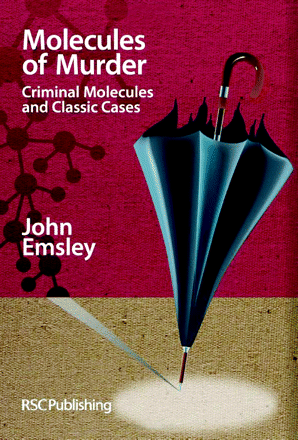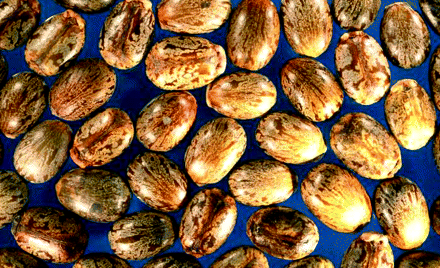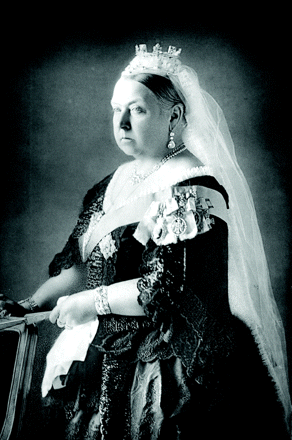Another Man’s Poison
- Christie Carrico, PhD

Molecules of Murder: Criminal Molecules and Classic Cases John Emsley. Cambridge: The Royal Society of Chemistry; 2008. 252 pages. $24.95. ISBN: 9780854049653
Molecules of Murder is a paean to forensic chemistry. It is also an eminently readable discussion of classic poisoning cases and the science behind them. The book covers five natural poisons (ricin, hyoscine, atropine, diamorphine, and adrenalin) and five chemical poisons (chloroform, carbon monoxide, cyanide, paraquat, and polonium). Each chapter contains an educational discussion of the history, chemistry, pharmacology, toxicology, and forensics of the poison, followed by a thoroughly engaging, often irreverent, telling of the particular case. Most of the cases described in this book have occurred within the last twenty years, and the most recent, the use of radioactive polonium to poison Alexander Litvinenko, occurred only three years ago.
In the chapter entitled Ricin and the Rolled Umbrella, Emsley relates the story of one successful and one apparently unsuccessful attempt by the Bulgarian secret service to murder two vocal defectors to the West. Georgi Markov’s fatal dose of ricin was delivered via a tiny metal pellet fired into his leg from an air gun disguised as an umbrella. Markov is one of the many of the victims in this book who received extensive hospital treatment but died as doctors struggled to understand the nature of the “illness.” Of course, there was little that doctors could have done for Markov even if they had identified the source of the patient’s aliments, because there is no antidote for ricin. The metal ricin-containing pellet was discovered only upon the inevitable autopsy. Vladimir Kostov also received a ricin-containing metal pellet, delivered to his back by an air gun, this time apparently hidden in a briefcase. In this instance, however, the pellet failed to release the toxic ricin. Kostov suffered only a mild illness, and only in the light of Markov’s autopsy were investigators prompted to discover the potentially fatal pellet the Kostov hosted in his back.
Dr. Hawley Harvey Crippen allegedly used scopolamine (hyoscine) to murder his wife, Belle Elmore, a popular singer in the early part of the twentieth century. Actually, it is not clear that she died from the poison, because the amount the doctor was known to have acquired would not have been lethal. The cause of death was further complicated by the untidy lengths that the doctor went to in order to dispose of his wife’s corpse. After dissecting her body, Crippen buried the flesh under the cellar floor; Belle’s head and bones never were found. After his wife’s demise, Crippen and his mistress, disguised as father and son, set sail for America. The attempted escape was foiled, however, when the “close” nature of the relationship between the father-and-son imposters caught the eye of the ship’s captain, who, having read newspaper accounts of Mrs. Crippen’s mysterious disappearance, notified police. As in all chapters in Molecules of Murder, the nefarious uses of the given pharmacological agent in this case, scopolamine are accompanied by a discussion of the agent’s more standardized, less criminal, uses.
Atropine has been a favorite poison throughout the millennia. Livia, wife of the Emperor Augustus, is suspected of using it to murder her husband so that her son could become emperor. Centuries later, it became a favorite of novelists, evoking visions of dark Victorian nights and languid ladies with large pupils. However, the true-crime atropine poisoning described in this book occurred in 1994, when Paul Agutter “improvised” the ingredients for his wife’s gin and tonic. (He also spiked atropine into several bottles of tonic water and placed them in a neighborhood Safeway store.)
Through a series of bad luck (on Mr. Agutter’s part), his wife wound up in the hospital shortly after consuming her cocktail, and her life was saved. The truly bizarre events of the story, however, occur after Agutter’s release from prison, when he attempts to return to his wife, only to be barred from the home by power of a restraining order. Consequently, he leaves Scotland, moves in with his parents in England, and lands a job, at the University of Manchester, teaching philosophy and medical ethics! Other uses of “natural” poisons include the serial murders perpetrated by Dr. Harold Frederick Shipman. He used diamorphine to kill as many as 887 of his patients, simply for the high he got from murder. A kindred spirit apparently existed in the person of Nurse Kristen Gilbert, who dealt with her more difficult patients by administering lethal doses of adrenaline.
In most of the cases discussed, the murderer gets caught and convicted even if it takes several years for the forensics to be properly elaborated. An exception is Adelaide Barlett, who was never convicted of killing her husband with chloroform. Emsley portrays Barlett not as an innocent, but rather as an adequate actress, relying on her beauty and playing the role of injured party. The medical use and abuse of chloroform is covered extensively, including its almost guaranteed success after Queen Victoria endorsed its anesthetic properties for child birth.
Several stories are told of attempts to use carbon monoxide as a murder weapon. One striking example focuses on Mr. Cranog Jones, who endeavored to convey carbon monoxide through a large pipe that he had extended from his garage and into his bedroom. He reasoned that a box, placed over his sleeping wife’s head, could collect the deadly gas from the end of the pipe and thereby terminate his marriage. Despite Mr. Jones’s ingenuity, the noise of the car engine was also conveyed through the pipe, which woke Mrs. Jones before she succumbed.
Cheryl Nixon was a successful barrister with really bad judgment when it came to men, the result being she died of cyanide poisoning while vacationing in Egypt with her boyfriend. In the chapter on cyanide, Dr. Emsley also covers the Tylenol poisonings in the 1980s in which someone managed to put cyanide into Tylenol bottles in the stores, resulting in the deaths of nine people. No perpetrator was ever identified, but hermetically sealed, nearly impossible-to-open bottles for pills and caplets resulted. Steve Catlin used paraquat to dispose of unwanted parents and wives, and it was only because his third wife continued to follow his “career” that he was brought to justice. Susan Barber got tired of being abused by her husband (not to mention being annoyed that he caught her in bed with another man) and so added paraquat to the gravy for his steak and kidney pie.

Although many of these stories seem almost comical, given the unusual situations in which they occur or the ineptitude of the unsuccessful criminals, one needs to remember that in most cases a person died. The story of Alexander Litvinenko has no comic overtones to it at all, and the horrendous agony and death he suffered due to radiation poisoning for political revenge is an appropriate ending for the book, reminding readers that poison is and always will be seen by amoral people as a way to dispose of inconvenient individuals without being caught. Fortunately, as Emsley emphasizes, the forensic chemists have an armamentarium of tools now at their disposal to make poisoning a less attractive means.
John Emsley is a British science writer who focuses on chemistry and pharmacology. Molecules of Murder was published by Britain’s Royal Society of Chemistry.
- © American Society for Pharmacology and Experimental Theraputics 2009







